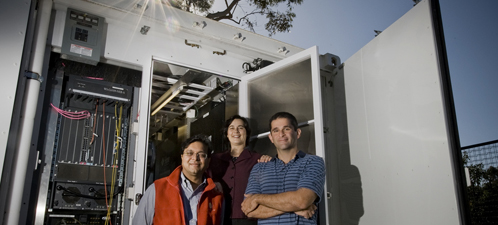




This is a draft alphabetical list of the campus academic partners Calit2 is working with to realize the institute's application vision in the energy sector. The list contains centers, facilities, labs and large grants, but Calit2 also works closely with many individual faculty, schools, and departments, as well as many private companies.
Advanced Power and Energy Program (APEP)
APEP addresses the development of energy technologies needed to meet the reliability, availability, maintainability and durability expected of advanced power generation systems. Emphasis is placed on highly efficiency and environmentally preferred central plants, distributed generation, combined cooling heat and power, sustainable community design and energy management, sustainable transportation systems, smart grid technology, energy storage, energy efficient building design, operation and controls, and the management of intermittency associated with large deployments of renewable solar and wind power generation sources. http://www.apep.uci.edu
California Traffic Report
Calit2 has been operating the California Traffic Report since 2003 with over 60,000 active users in San Diego, Los Angeles, Orange County and the Bay Area. The service provides personalized traffic reports, traffic alerts, best time to commute, and peer-to-peer incident reports. An iPhone App launched in February 2009 has been downloaded 40,000 times to date and continues to receive 150 downloads daily. Local media have extensively covered the service, and currently the traffic service's developers in the UCSD division of Calit2 are working with Caltrans to develop state-of-the-art ramp metering algorithms to improve highway throughput. http://traffic.calit2.net/
Center for Networked Systems (CNS)
CNS is a partnership of leading networked system technology providers and operators with leading networking researchers at UC San Diego. The center is a dynamic organization solving critical technical problems and accelerating the rapid growth of networked systems (both applications and adoption). CNS brings together interdisciplinary research activities and paradigms, engaging top graduate students and giving them the perspective and research training to solve critical technical problems. The center is also a critical mass of research talent developing technologies and foundations for robust, secure and open networked systems. http://cns.ucsd.edu/
GreenLight Project
This project led by the UCSD division of Calit2 is developing a GreenLight Instrument to support five communities of application scientists, drawn from metagenomics, ocean observing, microscopy, bioinformatics, and the digital media. The instrumentation allows scientists to measure and then minimize energy consumption, to make use of novel energy/cooling sources coming online at UC San Diego, and to employ middleware that automates optimal choice of compute/power strategies. This enables domain application researchers to continue to compete globally and to exploit the exponential improvements in silicon technology. http://greenlight.calit2.net
Institute for Transportation Studies (ITS)
A fundamental goal of ITS is the stimulation of interdisciplinary research on contemporary transportation issues. The UC Irvine institute involves faculty and students from the Henry Samueli School of Engineering, School of Social Sciences, School of Social Ecology, Paul Merage School of Business, Bren School of Information and Computer Science, and the School of Law. ITS hosts visiting scholars from the U.S. and abroad to facilitate cooperative research and information exchange, and sponsors conferences and colloquia to disseminate research results. The institute is also part of the University of California Transportation Center, one of ten federally designated centers for transportation research and education, and a member of the Council of University Transportation Centers. http://www.inrf.uci.edu
Integrated Nanosystems Research Facility (INRF)
The mission of INRF at UC Irvine is to develop and promote engineered nanoscale systems through research, education and outreach. Engineered nanoscale systems consist of microscopic and smaller systems comprised of mechanical, photonic, biological, electrical, fluidic and chemical subsystems. The vision of INRF-UCI is to provide the key technologies required to engineer the microworld. http://www.inrf.uci.edu
Microelectronics Embedded Systems Laboratory (MESL)
MESL is part of the Computer Science and Engineering department at UCSD and is led by Rajesh Gupta, Associate Director of the UCSD division of Calit2. The lab is interested in most aspects of embedded computer systems and sensor networks. Recent research has focused on energy efficiency at multiple levels and across subsystems (from radios and processors to networking and building-scale systems). Research projects span formal foundations to real-life system design and implementations. http://mesl.ucsd.edu/
National Fuel Cell Research Center (NFCRC)
The research in NFCRC at UC Irvine is directed to the development of low-cost, reliable and flexible stationary fuel cell power generation systems and fuel cell hybrids. Research is conducted on full-scale, grid-connected systems as well as critical component technologies such as controls, reformers, inverters and distributed power management. NFCRC aims to accelerate the development and deployment of practical systems into the market, and to explore and demonstrate strategies that successfully integrate fuel cell attributes into the built environment. Dedicated by the U.S. Department of Energy and the California Energy Commission, the NFCRC works closely with industry and supports the California Stationary Fuel Cell Collaborative in association with the California Air Resources Board. http://www.nfcrc.uci.edu/2/default.aspx
Nano3
Calit2's Nano3 facility at UC San Diego provides advanced capabilities for fabrication and characterization in a state-of-the-art clean room environment. The name reflects the synergetic nature of the facility, focusing in the space on three fields of nanoscale research and development: nanoscience, nanoengineering and nanomedicine. In addition to providing essential nanofabrication capabilities for research on electronic and optoelectronic materials and devices, Nano3 facilitates the pursuit of research in emerging, interdisciplinary and growing fields such as biomedical and biochemical devices, heterogeneous integrated devices and circuits, and sensor technology. http://nano3.calit2.net/
Pacific Rim Consortium on Energy, Combustion, and the Environment (PARCON)
PARCON at UC Irvine encompasses universities and industry in the Pacific Rim that share the responsibility of maintaining a healthy common air resource and preserving natural resources. PARCON emphasizes communication and the exchange of technologies and tools available to address global energy challenges, with immediate focus on those germane to the region. PARCON was established in 1992 to advance the evolution of energy and environmental control technologies, and to promote more informed decision-making. http://www.parcon.uci.edu
Service Oriented Software and Systems Engineering Laboratory (S3EL)
S3EL researches innovative techniques for software and systems engineering using a service-oriented approach. Director and UCSD computer science professor Ingolf Krueger also leads the software and systems architecture and integration team (SAINT) at Calit2, which provides a rich set of software engineering services to large-scale systems-of-systems integration projects within Calit2, such as the NSF-funded Ocean Observatories Initiative (OOI) CyberInfrastructure (CI), GreenLight, CitiSense and Automotive Service-Oriented Software and Systems Architecture (ASOSA) projects, as well as the NIH-funded P41 Center for Computational Mass Spectrometry (CCMS), PALMS - Cyber-Enabled Measurement of Health Behaviors in Time and Space, and Cyberinfrastructure for Comparative Effectiveness Research (CYCORE) projects. S3EL also offers a full spectrum from requirements engineering, software architecture and design, implementation, quality assurance and deployment services for innovative software and systems architecture and integration projects. http://seelab.ucsd.edu/
System Energy Efficiency (SEE) Lab
Energy consumption is a critical constraint in the design of modern computer systems. Directed by UCSD electrical and computer engineering professor Tajana Simunic Rosing, research in the SEE Lab addresses energy efficiency in systems of all sizes, from sensor nodes to processors to data centers. Portable systems, such as mobile embedded systems and wireless sensor networks, typically operate with a limited energy source such as batteries. The design process for these systems is characterized by a tradeoff between high performance and low power consumption, emphasizing the need to meet performance constraints while minimizing power consumption. Decreasing power consumption is also an important factor in lowering the packaging and the cooling costs of embedded systems. On the other end, stationary systems also require energy efficiency due the operating costs and environmental concerns related to desktops, servers and data centers. Current data centers are increasingly limited by power and thermal capacity. The annual energy cost of a large data center can be in the range of millions of dollars, and the cooling cost is about half of the total energy cost. Energy efficient and temperature-aware approaches address these large-scale systems at different levels, such as the whole data center, computing clusters, servers or components such as processors, disk drives, etc. http://seelab.ucsd.edu/
UCI Administrative and Business Services
UCSD Resource Management and Planning (RMP)
RMP oversees the acquisition, effective management and/or disposition of financial, physical and real property resources. With the Strategic Energy Initiatives, RMP has embarked on developing and deploying a portfolio of innovative, renewable energy projects that will produce more than seven megawatts of energy at UC San Diego. Calit2 works closely with the principals of these initiatives to leverage facilities investments into next-generation research infrastructure. http://www-vcrmp.ucsd.edu/
UCSD Sustainability Solutions Institute (SSI)
SSI turns knowledge and technology into solutions. Created in January 2009 and building on recent cross-campus initiatives and long-standing academic and research programs, SSI acquires resources and organizes projects to address sustainability challenges. Initial focus areas include integrated resource management (starting with climate impacts on water systems); the built environment and sustainable communities; and Greenovation, a program for research commercialization. http://ssi.ucsd.edu
Zeiss Center of Excellence
A partnership between Calit2@UCI and Carl Zeiss SMT, a global semiconductor and nanotechnology instrument manufacturer, the Zeiss Center located on the first floor of the Calit2 Building at UC Irvine is equipped with state-of-the-art electron microscopes that are available to faculty, students and industry users on a recharge basis. The Zeiss Center is a shared resource, and it includes instruments supplied by five other equipment vendors as well. http://www.calit2.uci.edu/calit2-building/itemdetail.aspx?cguid=b40a13f3-332c-4bec-94e1-317f39373900
